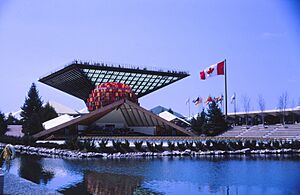Canadian Pavilion facts for kids
The Canadian Pavilion was a super cool building at Expo 67 in Montreal. It was famous for its unique upside-down pyramid shape and a special exhibit called the "People Tree." This pavilion was incredibly popular, especially on Canada Day (July 1), 1967, when it had its most visitors in a single day.
The giant inverted pyramid was named Katimavik. This is an Inuit word that means "Gathering Place." Imagine a building nine storeys tall, but upside down! It was held up by four strong columns. Inside, at its base, was a special rotating theatre. This theatre moved audiences from one movie screen to another, completing a full circle every half-hour.
Around the main pyramid, there were smaller, connected pyramids. These held exhibits like "The Land of Canada," "The Growth of Canada," and "The Challenge to Canadians and Canada and the World." The pavilion was built on a large piece of land, about 7½ acres, on Notre Dame Island. It cost $24 million to build. The huge inverted pyramid weighed 1000 tons and had a hollow steel frame. Its inner walls were open to the sky and featured giant sculptures of a sun dial, hour glass, compass, and Haida masks.
Contents
Designing the Canadian Pavilion
How did the Canadian Pavilion get its unique look? The main architect for Expo 67, Édouard Fiset, first wanted the Canadian Pavilion to be much smaller. But architect Rod Robbie strongly believed Canada's building should be the biggest at the fair. He pushed for a much larger space, and with help from federal minister Mitchell Sharp and pavilion commissioner H. Leslie Brown, Robbie's idea won!
The upside-down pyramid shape of Katimavik came about by chance. Robbie and his team were working with cardboard boxes to plan the buildings. Someone placed a large, green, inverted pyramid-shaped ashtray among the boxes. This simple object sparked the idea for the amazing Katimavik design!
Who Designed the Pavilion?
The Canadian Pavilion was designed by several talented architects. The main designers were Rod Robbie and Colin Vaughan from their firm, Ashworth, Robbie, Vaughan and Williams. Other important architects included Paul Schoeler and Matt Stankiewicz. They worked together to bring this incredible vision to life.
The People Tree Exhibit
What was the "People Tree"? In front of the pavilion, there was a unique art installation called the "People Tree." It was made of orange and red nylon sheets, designed to look like a maple tree in autumn leaf colour. This "tree" stood 60 feet tall! It had a thousand "leaves," and half of them had pictures of Canadians printed on them, showing people working and playing. You could even walk up a spiral staircase to explore the tree.
Other Cool Structures at the Pavilion
What else could you see there? Besides the main pyramid, the Canadian Pavilion site had other interesting buildings. There was an Arts Centre with a 500-seat theatre. This centre also showed art and handicrafts and had a library. The theatre had a special Casavant Frères organ, and Canadian organists played free concerts there every day.
The site also featured a Children's Creative Centre, a fun place for kids. There was also a restaurant called "La Toundra." A Canadian composer named Otto Joachim even created special four-channel electronic music that played throughout Expo 67 at the pavilion.


